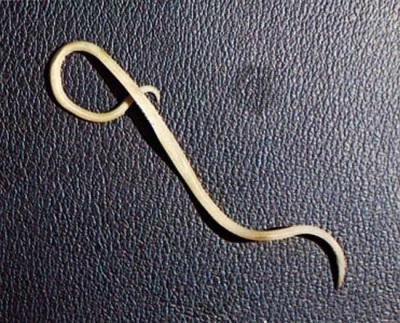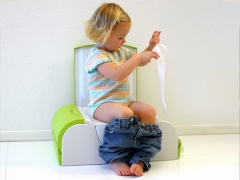White or light feces in a child
Normally, the color of the child’s stool is yellow-brown in color, and therefore the discoloration of the feces may frighten adults. Why can the baby's feces turn white and what should the parents do in this case?
The reasons
White feces are a sign of fairly serious diseases of the digestive tract, and non-dangerous symptom of changes in nutrition.
Newborns
Fecal mass allocated to newborns can change their appearance depending on the nutrition of the baby. If a child receives mother's milk, the mother’s food also affects his chair.
Lightening the chair of a newborn baby happens when the mixture is added. Usually it is temporary and after 2-3 days the color of the chair becomes familiar again. Bright feces often appear in the newborn, as a result of the use of antibiotics in the baby.

In older children
Light color of feces in children older than one year may appear due to:
- Infectious lesions of the gastrointestinal tract (often rotavirus infection).
- Hepatitis A.
- Inflammatory processes in the pancreas.
- Problems that cause bile stasis, such as bending, twisting, or obstruction of the gallbladder.
- Whipple's Disease. In this case, the child is emptied very often, and the fecal masses are foamy and smell very unpleasant.
- Taking drugs that disrupt the liver, for example, antibiotics, anti-inflammatory drugs, antifungal drugs and others.
Periodic appearance
A short periodic change in the color of the stool (its lightening) is associated with changes in the nutrition of the baby or the nursing mother. If the color of the feces was influenced by the products of the mother's menu, the changes in the stool take 10-24 hours. If a light-colored chair appears under the influence of a mixture, the color usually becomes normal within two to three days. Also, periodic clarification of the stool in babies older than 6 months may be associated with complementary foods.
The use of an excess of fatty foods, such as butter or sour cream, leads to a lighter color of the stool. If parents notice the regular appearance of diluted light feces, this may be an indication of problems with the digestion of fatty foods in the intestines of the baby.
White mucus or plaque
If white mucous clots appear in the child’s stools or the stools are covered with a whitish bloom, this may be a sign of proctitis or rectal fistula. Usually, simultaneously with this picture of feces, the child suffers from pain in the anus. Also, the baby may increase body temperature. With these symptoms, it is important to immediately consult a doctor.
White lumps or blotches
Often these blotches are undigested food particles (usually vegetable). They may look like grains, grains, small lumps, fibers. No actions are required for such a pattern of fecal masses, especially if the child’s well-being is not disturbed.
Worms
Almost all worms coloring white or light yellow. Most often, mothers can see in the feces of pinworms, which are small worms about 3-4 mm long. If the size of the worms is larger, then it may be dead roundworm. Having seen white worms in the baby’s feces, it is necessary to pass tests and treat the child under the control of a parasitologist.

Combination with pain, fever or darkening of urine
If inflammation of the pancreas has caused changes in the color of feces, then the child will also complain of abdominal pain.
In the case when the stool has become discolored suddenly, the child has darkened urine, fever and side pains on the right, there is a high probability that acute cholecystitis or hepatitis is manifested in this way. These are dangerous symptoms, so when they appear, it is important for parents to call a doctor as soon as possible.
What to do?
Noticing the white or light yellow feces in a child for the first time, observe the color and consistency of the feces for several more days. If the changes in the color of feces have taken place on their own in a short time, and the child’s well-being has not deteriorated, there is no need to worry and do anything. If the child complains of pain, and you notice other adverse symptoms, it is important to consult a specialist and rule out the presence of diseases of the digestive tract.

When should I call a doctor?
Be sure to contact your pediatrician if your child has the following symptoms besides the light color of feces:
- Severe bloating.
- Nausea as well as vomiting.
- Increased temperature.
- Stomach ache.
- Yellow color sclera and skin.
- Dark color of urine.
- Poor appetite and weight loss.
- Weakness, capricious behavior, sleep disturbance.
- Great thirst.






